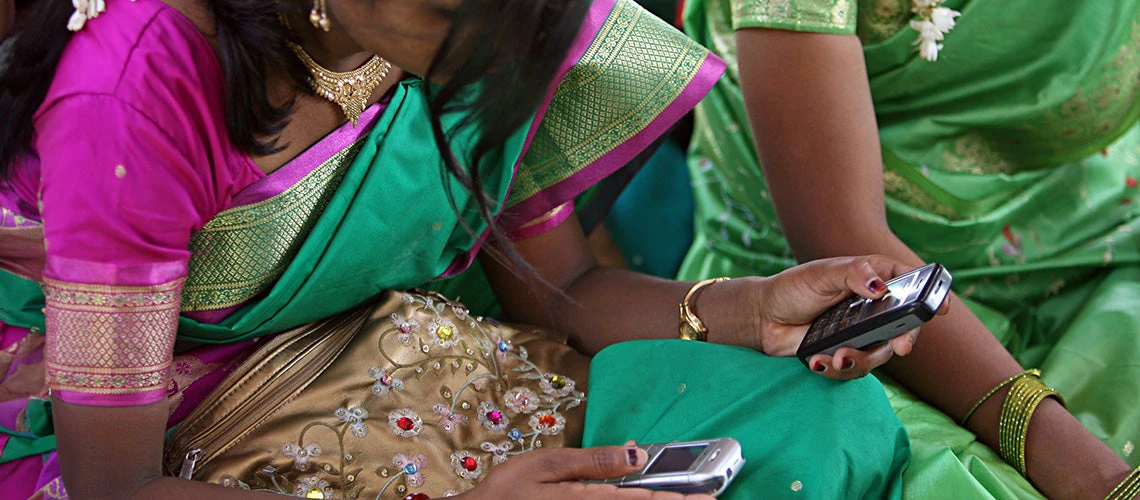 Young women look at their cellphone during a community meeting. | © Simone D. McCourtie / World Bank
Young women look at their cellphone during a community meeting. | © Simone D. McCourtie / World Bank
In recent years, the dark side of the internet has become increasingly apparent, with online violence against women and girls emerging as a significant problem.
Heartbreaking cases like that of 26-year-old Athira from Kerala, who took her own life following persistent cyber-violence, underscore the gravity of this issue. Girls as young as 12 in Spain, women in Pakistan, and female users of Facebook and WhatsApp in Peru are facing similar forms of cyber-harassment.
The rise of the internet, social media, and mobile connectivity has facilitated various forms of online violence, including cyber harassment and bullying, cyber stalking, online gender-based hate speech, flaming, image-based sexual abuse, and doxing.
These acts not only widen the digital gender divide, by deterring women and girls from online participation; but also extend the scope of gender-based violence from the physical to the digital realm. This shift poses a significant threat to women’s political participation and freedom of expression, especially those involved in politics, journalism, and activism. Young girls are particularly vulnerable, often being the targets of severe online predation.
A European Union study reveals that 73% of women have experienced online abuse (EU Agency for Fundamental Rights 2014). In Germany, a survey indicated that women are more likely to face cyber harassment and stalking than men. The United Nations estimates that 95% of online aggression, harassment, abusive language, and denigrating content are directed at women.
In response to this escalating problem, the Women, Business and the Law team conducted research in 2021 and 2022 to examine global legal protections against cyber harassment. Their findings, published in the report "Protecting Women and Girls from Cyber Harassment: A Global Assessment of Existing Laws," reveal a concerning lack of comprehensive legal frameworks:
- Only 30 percent of economies worldwide provide legal protections against cyber harassment. Most economies still lack legislation to protect women and girls from cyber harassment or bullying. Only 58 of the 190 economies analyzed have enacted some legislation on this topic. Cyber harassment laws are more common in high-income economies than in low- and middle-income economies. Yet only about 33 percent of the analyzed high-income economies have such laws. The Middle East and North Africa and Sub-Saharan Africa show even more room for improvement, with 20 percent and 25 percent of economies having such laws, respectively.
- Only 12 percent of economies globally have established legal protections specifically addressing cyber-sexual harassment. Out of the 22 countries with such laws, none is located in South Asia and only one economy in the East Asia and Pacific region, the Philippines. And in Latin America and the Caribbean, eight economies out of thirty-two (Belize, Dominican Republic, El Salvador, Guyana, Mexico, Nicaragua, Peru, St. Vincent and the Grenadines) have laws that address cyber sexual harassment.
- Only 27 percent of economies have redress measures for cyber harassment. Globally, 53 out of 190 economies impose criminal penalties for offenses associated with cyber harassment. Such penalties often include imprisonment, a monetary fine, or a combination of the two sanctions. Some economies also prescribe harsher penalties for repeat offenders. Regarding civil remedies, however, very few economies have included provisions in their cyber harassment legislation. Only seven economies (Bhutan, Guyana, Israel, Kenya, Mexico, Trinidad and Tobago, Uganda) provide for either damages or financial compensation (or a combination of both) for victims, in addition to criminal penalties.
- Nineteen economies have established special procedures for cyber harassment. These are addressed in cybercrime acts or legislation specifically pertaining to Information and Communications Technology (ICT), which tend to provide a procedure that is globally applicable to all ICT-related crimes.
- Women with disabilities and children are unprotected in the majority of countries. Among the 58 economies that have legislation on cyber harassment, only 9 specifically protect women with disabilities from cyber harassment. And only 21 economies have legislation specifically protecting children from cyber harassment.
- Laws cover less than half of the global population of women, and less than 12 percent are protected by special provisions. At the global level, 2,473 million women in 183 countries, which corresponds to 47 percent of the population of women in those countries, are protected from cyber harassment under the law, and only 12 percent by legislation on cyber-sexual harassment. Further, only 3 percent of women have access to civil remedies for cyber harassment, and 11 percent to special procedures for these types of cases.
A new Brief analyzing the data, reveals that legal protection against cyber harassment is weak globally, regardless of region or income level. Women, Business and the Law is updating its data and analysis to include legal protections against cyber harassment. This update, to be published in 2024, includes assessing cyber harassment laws, criminal penalties, civil remedies, and practical implementation frameworks, such as special procedures, courts, government agencies handling complaints, and protection orders like removing offensive online content.
This research aims to highlight the urgency for comprehensive laws to prevent online violence and create a safer digital environment. Prioritizing the fight against cyber harassment and bullying is essential in the digital age. Enacting robust legislation is a vital initial step for governments to unequivocally condemn such behavior. Women, Business and the Law's data will aid governments in this endeavor.



Join the Conversation